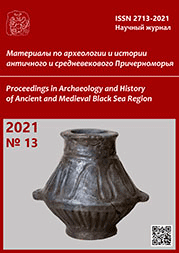Привозные эллинистические монеты, найденные близ с. Партизанское (Юго-Западный Крым), как исторический источник
Imported Hellenistic coins found near Partizanskoe village (Southwest Crimea) as a historical source
Author(s): Denis Andrievskij, Mikhail M. ChorefSubject(s): History, Archaeology, Cultural history, Economic history, Ancient World
Published by: Нижневартовский государственный университет
Keywords: archaeology; history; numismatics; Scythian; imported coin;
Summary/Abstract: Our attention was attracted by rather small yet interesting numismatic sample of the Hellenistic times. The coins were gathered at the beginning of the 2000s by the residents of the village on the present-day surface of the Tavel hill. The sample consists of bronze coins minted in Syracuse under Hiketas II and Hieron II as well as in Alexandria or in Cyprus under Ptolemies II, VI, and VIII, as well as IX or X. Judging by the fact that coins were released by rather remote polities using different standards of coinage based on low-value bronze alloys, it seems unlikely that they could be simultaneously used in Southwest Taurica as means of payment. We believe that we are dealing with offerings repeatedly made for the local sanctuary which situated upon Tavel hill between the 3rd and the 1st century BCE. We assume that the reason why coins were donated to the sanctuary was that the images placed on them were honored. The very fact of the discovery may surely testify that some contacts took place in the time range mentioned above between the population of the foothills of Taurica and those of the polities in Central and Eastern Mediterranean.
Journal: Материалы по археологии и истории античного и средневекового Причерноморья
- Issue Year: 2021
- Issue No: 13
- Page Range: 875-881
- Page Count: 7
- Language: Russian

